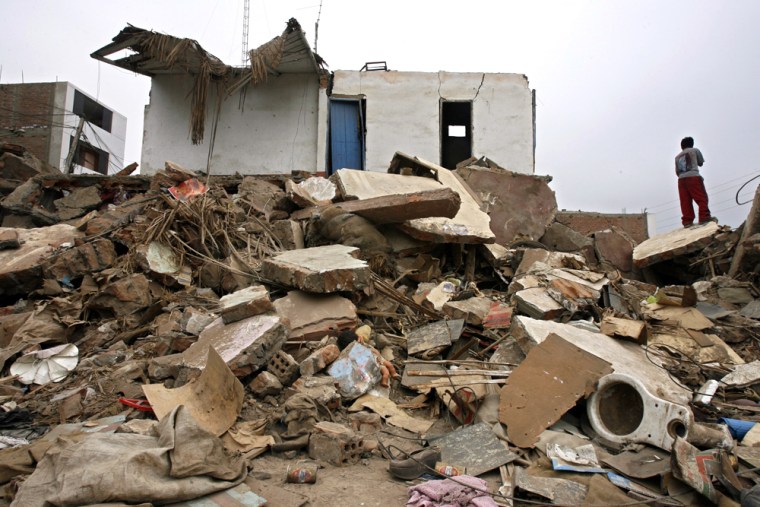Rescuers gave up hope of finding any more survivors and concentrated Monday on clearing tons of rubble from the streets of a southern port city leveled by a powerful earthquake that killed at least 540 people.
The magnitude-8 quake on Wednesday destroyed more than 85 percent of the homes in Pisco, a fishing port 125 miles southeast of Lima that was the hardest hit city.
Rescue workers have removed 148 bodies from a church in the city after its domed ceiling broke apart during the earthquake. It was not clear how many of the 300 congregants inside survived the shaking that lasted for an agonizing two minutes.
Jorge Vera, a firefighter who led the operation to find survivors at the San Clemente church in Pisco, said Sunday the rescue work had stopped and the focus was now on recovering the bodies. Friday was the last time a survivor was pulled from the quake’s debris.
Peru plans to rebuild
Meanwhile, the government was preparing plans to rebuild Pisco.
“I am traveling with the head of the Civil Defense to Pisco to begin the clean-up,” President Alan Garcia said early Monday in Lima after he returned from heading rescue operations in Pisco for the past four days.
Garcia said plans include providing small two-bedroom homes to people who lost their houses, made with stronger material — most likely concrete blocks and steel rods, which can withstand earthquakes much better than unreinforced adobe.
He also said 1,200 soldiers had restored calm to the streets where days earlier, hungry quake victims looted aid trucks and markets.
The Vatican on Monday joined other international donors, saying it had sent $200,000 in aid for quake victims.
Some 280 planes arrived with 600 tons of food and other supplies destined for quake survivors, and navy ships had brought potable water.
“No one is going to die of thirst or hunger in these cities,” Garcia said on Sunday.
Aid slow to reach hard-hit areas
But aid was still slow reaching the outlying areas of Pisco.
Teresa Casavilca, 40, walked and hitchhiked in search of food with her 1-year-old son, wrapped in a flowered sheet on her back, from her rural home about six miles outside of Pisco.
“The planes with help go by every moment,” Casavilca said. “Where does that help go? Nothing gets to us. My son cries all night from the cold because we’re sleeping outside.”
Only a trickle of aid was reaching hard-hit mountain communities further inland, said Yerma Canales, director of social services in Castrovirreyna, 140 miles southeast of Lima.
“Help has not gotten to us yet, just a minimal part,” Canales said.
She said the region’s adobe houses were severely damaged in the quake. Families moved outdoors for their safety, where children are falling ill in the cold weather.
“People are no longer sleeping in their homes,” Canales said. “They are going to parks, fields and open ground because aftershocks are happening all the time.”
Aid workers estimated during the weekend that up to 80 percent of people in urban quake-hit areas may not have access to clean water.
Local media reported late Sunday that a 12-year-old boy in the village of Guadalupe near Pisco was killed when a wall of his house fell on top of him following a magnitude-5.6 aftershock.
